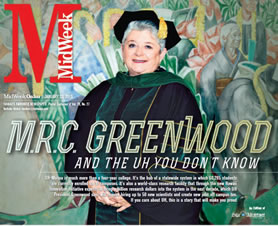M.R.C. Greenwood
“America’s future economic growth and international competitiveness depend on our capacity to innovate,” President Barack Obama states. “To win the future, we must out-innovate, out-educate and out-build the rest of the world.”
Where America once led the world in college graduation rates, it now ranks 16th of 26 developed countries, according to national education statistics.
cover_2
What is Hawaii’s game plan for meeting the challenge?
Hawaii Graduation Initiative focuses on increasing the number of college graduates by 25 percent by the year 2015 (10,500 graduates). The program is designed to address access, attainment and affordability of higher education.
“Simply put, we want more local students to attend and graduate from UH,” says Greenwood.
Progress can be seen in the 20 percent increase in UH graduates since 2008. In fall 2012, there was a 14.7 percent increase in the number of students taking 15 credits or more systemwide. Total enrollment stands at 60,295, with 81 percent Hawaii residents.
Innovation and Technology Transfer is a five-year plan to improve efforts at commercializing (for profit) the technology UH professors and researchers create. The impact expands Hawaii’s knowledge-based industry, diversifies the state’s economy and results in thousands of jobs in public-private partnerships.
“Creating knowledge is a contact sport,” says Greenwood. “It takes people with a common vision to make a very good university a great one.”
Renovate to Innovate calls for investing in superior campus facilities through repairs, maintenance and construction. UH Board of Regents approved a capital improvements budget, subject to legislative approval, of more than $230 million for various projects.
Obviously there are many dimensions to running a university system. Not the least of the president’s duties is being a listening post for stakeholders and others with a vested interest in the viability of Hawaii’s sole institution of higher education.
Greenwood, staff and regents recently completed 10 community forums to hear comments and concerns from attendees.
“It is increasingly clear to me that, by and large, most of the public does not understand what the university really stands for and what it really does,” she laments. “People think of college as just another four years after high school. We need to do a better job of helping people understand that it’s not the same.”
The 14th UH president was hired in August 2009 and is the first woman to serve as its chief executive officer.
“I’ve been the first female in any number of positions, including dean of graduate studies at UC-Davis, chancellor at UC-Santa Cruz, provost for the UC system and now president at the University of Hawaii,” Greenwood says.
“Certainly I’ve experienced the loneliness of being the only woman in the room,” she reflects. “My attitude has always been just keep doing the work and demonstrating that you’re interesting and interested, and most people are drawn to that.”
Greenwood also knows something about struggling to get a college education.
The eldest of four sisters, she was born in Florida to an Army nurse and a physician. She grew up in Auburn, N.Y., fond of books and animals, and dreamed about becoming a veterinarian, according to an article in UH’s Malamalama magazine.
Greenwood married at the end of her senior year in college and made “the usual choice in those days,” going to work while her husband went to school. They had a child, he went to the Vietnam War, the marriage ended and she found herself facing, at 21, the daunting challenge of putting herself through Vassar College while raising a young son.
“I was one of the few single moms,” she recalls. “I worked 25-30 hours a week and was on scholarship the whole time.” In her sophomore year, an anonymous donor began paying her tuition. “That shaped the way I feel about giving back to higher education ever since,” she says in the article.
Joining forces with another single mother to share childcare responsibilities, she discovered the value of a surrogate family. Forty years later, she and partner Patricia Johnson are doting grandparents to six grandchildren. Greenwood and Johnson served together on the faculty of UC-Davis and are research scientists in the field of nutrition.
Asked what attracted her to Hawaii, Greenwood observes that the UH is one of the few unified college systems in the country.
“Hawaii has community colleges, four-year institutions, research and professional learning centers all in one system,” she states. “After 20 years of beating my head against the wall in a big state system that competes for resources, I was intrigued by a system that is integrated and thrives on interaction and exchanging ideas. The outcomes are very gratifying.
“We can be the best-performing university system in the country,” she touts. “We can be the top research and work-development institution, as well as the seat of creating knowledge that is internationally relevant. My background is oriented to bringing value to a state economy,” Greenwood says of her role. “It has taken three years to build the foundation for programs like the Hawaii Innovation Initiative to make the university a bedrock of opportunity.
“You can criticize academic institutions for being slow-moving and for having antiquated ways of doing things – all of that is true – but we are resilient, we endure and we deliver,” she says.
Many are counting on it, knowing that confident, inspired leadership makes the difference in scoring goals.
Could this be her clutch play?







